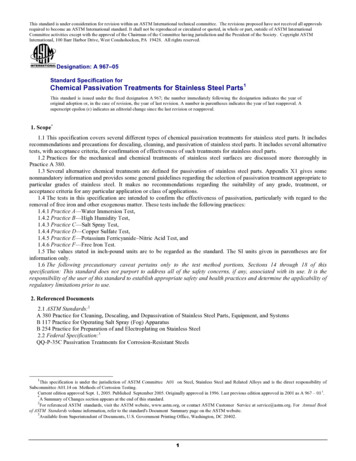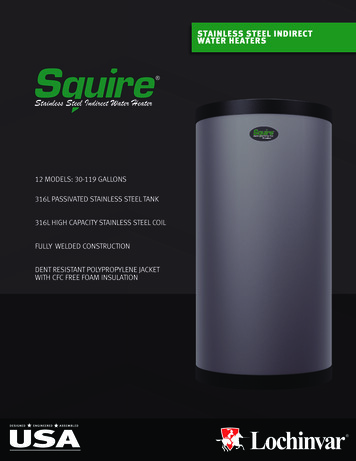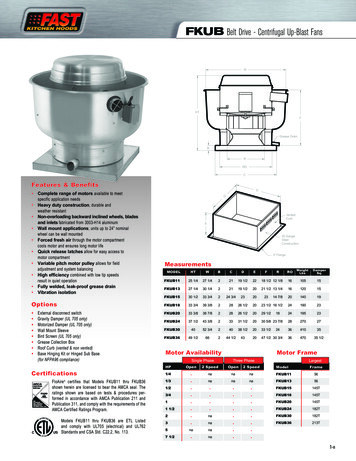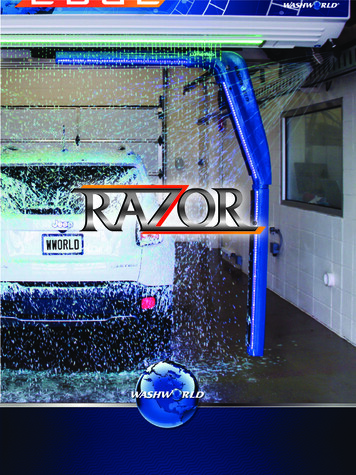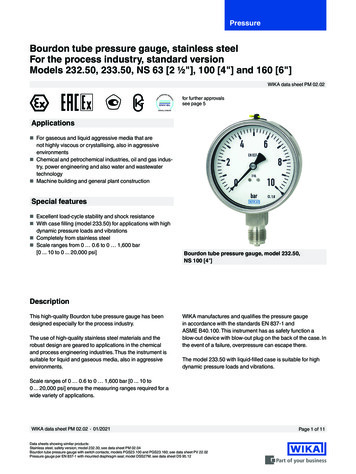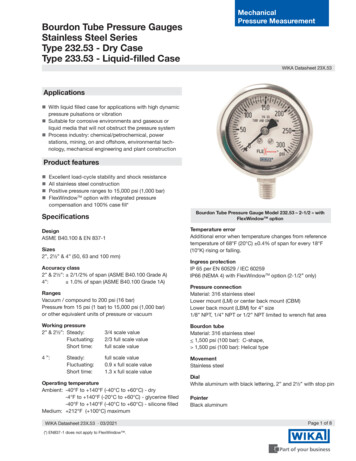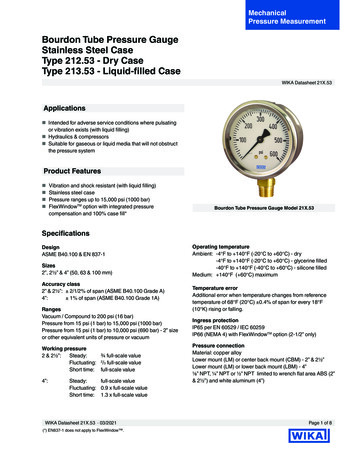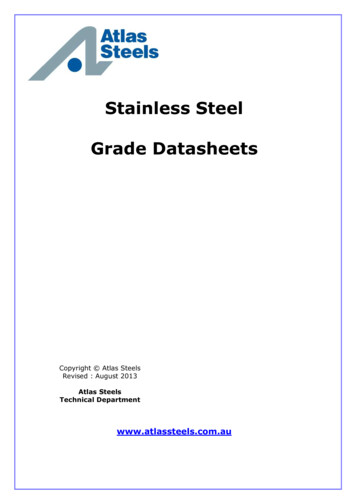
Transcription
CWA Conference 2012Quebec City, QCSeptember 10-11, 2012MONITORING PASSIVATION ON STAINLESS STEEL WITHOPEN CIRCUIT POTENTIAL TECHNOLOGYNathalie VézinaProduct Manager, Research & DevelopmentSURFOX systemsWalter Surface TechnologiesPASSIVATIONStainless steel is an alloy that contains iron and at least 10.5% chromium. Other elements such as nickel, molybdenum, and manymore may also be present depending on the grade of stainless steel. Stainless steel gets its amazing corrosion protection properties from the presence of chromium in the alloy. The chromium present reacts with oxygen to form a thin chromium oxide layeron the surface of the workpiece, thus preventing the reaction of iron with oxygen which forms iron oxide: rust. The thinchromium oxide layer acts as a barrier between the iron rich bulk alloy and the oxygen rich ambient air.To passivate, the surface of stainless steel must be completely free of contaminants. Heat tint from welding as an example is amajor contaminant that must be removed from the surface, not only for aesthetic reasons, but specifically to allow the stainlesssteel to passivate itself.The passivation process begins immediately after the contaminants are completely removed from the surface of the material. Thechromium content in stainless steel at the surface of the material then reacts with oxygen in ambient air to form a passive layerof chromium oxide on the surface of stainless steel. It takes between 24 to 48 hours to achieve a uniform and stable passive layer.ABSTRACTPassivation of stainless steel parts is of crucial importance in order to maintain its corrosion protection properties. Mostspecifically, heat affected zones on welded stainless steel are vulnerable areas that require specific care and should bethoroughly tested for passivation in order to avoid corrosion issues. The optimization of the passivation on stainless steelparts depends largely on our knowledge of the passivation process itself and the methods used to test the manufactured parts.A suitable test method is instrumental in validating proper passivation of parts for various industries such as food & beverage, pharmaceutical and other industries using stainless steel components for their specific needs. Several existing methodsare currently available and are well known to most manufacturers, but do they really meet their specific needs?PASSIVATION PROCESSCr2O3 Protective oxide layerOver time, other methods have been developed to meet the growing needs of manufacturers. Particular attention will begiven in this document to the Open Circuit Potential technology and the added value of this new test method that offersflexibility, a clear economic advantage and accuracy that was previously unattainable.ChromiumStainless steel partfree of contaminant.Stainless steel manufacturers need to select a test method which fulfills all of their needs. One important selection criteria is howquickly the test can generate results; quicker is normally better. The accessibility and the ability to perform the test on site arealso important considerations. The fact that most of the known tests will damage and stain the stainless steel parts also reducesthe range of solutions offered to manufacturers.The following tests will detect free-iron on parts and will provide pass or fail results:The chromium content in the stainless steelreacts with oxygen in ambient air.The chromium oxide layer is reformedand protects against corrosion.Sand blastingSand blasting will remove the heat tint, but will embed a plethora of other contaminants into the stainless steel, which couldhinder and limit the self passivation of material. This method is not considered ideal for repairing damaged stainless steel.Pickling pastes and gelsPickling pastes and gels will remove the heat tint and every other inorganic contaminant from stainless steel parts. However,these pastes and gels usually contain mixtures of nitric and hydrofluoric acids. Nitric acid vapours are very harmful to the humanrespiratory system and hydrofluoric acid will cause severe damage to the skin. Not only are the pickling pastes and gels very toxicto human beings, but they also alter the surface of stainless steel. Electrochemical cleaning and polishingElectrochemical cleaning and polishing is by far the safest and most efficient method of removing heat tint and other contaminants from stainless steel surfaces. Electrochemical polishing removes more iron and nickel, leaving the surface rich in chrome.Walter offers a weld cleaning and polishing system known as SURFOX which will remove heat tint from surfaces at a speed of3 to 5 feet per minute. This system uses food grade acids and electricity to remove the heat tint. SURFOX is certified ASTMA967-05/A380* for passivation.* ASTM A380 Standard provides definitions and describes best practices for cleaning, descaling and passivation of Stainless Steel Parts,Equipment and Systems. ASTM A967 Standard provides tests with acceptance criteria to demonstrate that the passivation procedureshave been successful.As per ASTM International Standards; “passivation testing is the process by which stainless steel will spontaneously form achemically inactive surface when exposed to air or other oxygen containing environments. Passivation testing involves theremoval of exogenous iron or iron compounds from the surface of the stainless steel, by means of a chemical dissolution, mosttypically with an acid solution that will remove the surface contamination but will not significantly affect the stainless steelitself.”The chromium oxide layer can be damaged by:Thermal treatments such as weldingMechanical abrasionGalvanic corrosionStrong acids1EXISTING PASSIVATION TEST METHODSAny steel or iron that comes in contact with stainless steel is a potential source of contamination. Tools such as grinding wheelsand wire brushes previously used on steel or iron parts are susceptible to transfer iron to stainless steel surfaces. One of the mostdifficult sources of iron to avoid is the atmosphere itself. Industrial areas have a surprising amount of iron in the air. This ironfalls onto exposed items, including previously cleaned stainless steel parts. To ensure proper passivation of stainless steel components, the surface must be free of contaminants such as free iron. Test methods exist to determine the presence of free iron onstainless steel surfaces.Grinding and polishingGrinding the welds off completely removes the heat tint. However, there might be traces of free iron left behind which can causepitting and corrosion. To ensure that this free iron is removed, a post chemical treatment with an acidic product is required. Thesituation is different for mirror finishes where the corrosion resistance of the stainless steel parts are greatly enhanced due to theuniformity of the material itself after the polishing process. The drawback of this method is that it is labour intensive and willalter the surface fininsh.OxygenFe C Cr (min. 10.5%)PROBLEM STATEMENTOften microscopic cells are present on the surface of the delivered work piece, but cannot be located and detected visuallyprior to shipment. These later spread and become visible, creating a phenomenon known as pitting and corrosion. That iswhy it is important for a manufacturer to ensure that the work piece is properly passivated before it is put in service. On siterepair and refurbishment is costly for the manufacturer and the need exists for a clear diagnostic tool capable of monitoringthe state of the passivation before it leaves the shop.Several methods are available for restoring thermally damaged (from welding) stainless steel:23ALTERNATE METHODTo summarize, the Open Circuit Potential method offers the following advantages:Open Circuit Potential TestersWalter Surface Technologies has recently launched a compact and portable testing device which is capable of qualifying thestability and thickness of the passive chromium oxide layer of stainless steel. This device works on the principle of Open CircuitPotential. Open Circuit Potential is the difference of electrical potential between two terminals. The tester measures theinterface potential of the chromium oxide layer versus the underlying steel. A numeric value of the quality of the passive layerwill then be read in about 20 seconds. This tester can also be used to monitor the evolution in time of the passive layer. Thepassivation tester will indicate a positive reading within a couple of hours of properly cleaning and decontaminating thestainless steel surface.******The thin profile of the test probe allows for the collection of readings in small and very specific areas. Multiple readings can betaken in order to maximize reliability and reproducibility. A negative value will indicate that the part being tested is not passivated.A positive value will indicate that the part is passivated. The higher the value, the thicker and more resistant the passive layer.CONCLUSIONPassivation of stainless steel parts and structures are unquestionably a concern for welders and manufacturers in many industries. For economic reasons, manufacturers want to minimize rework costs of rusted parts and structures in the field. Fortunately,new techniques are being developed to help manufacturers ensure the quality of their parts. The Open Circuit Potential methodis a reliable, effective and accurate method to measure passivation and minimize rework costs.Water immersion testThis test may seem attractive at first sight since water is often easily accessible. However, it may take several hours before beingable to see any results. Not to mention that if the part is improperly passivated, it will have a tendency to rust and will probablyneed to be reworked before being tested again.Qualifies the quality and thickness of the protective chromium oxide layerProvides a numeric value instead of a pass and fail result onlyProvides fast and accurate readings (about 20 secs.)Will not damage the surface being testedAllows for onsite measurementsAllows recording and uploading of measured dataIt is also important to ensure that the water is clean. The water used for the test should not contain iron (from plumbing forinstance) or chemicals, otherwise the test result may falsely indicate that iron is present on the surface the part.About Walter Surface TechnologiesHumidity testThe humidity chamber test requires specific equipment and a capital investment. Unless the manufacturer is properly equipped,stainless steel parts will be sent to an external laboratory. It may be easy to outsource humidity testing for small stainless steelparts, but larger parts may be problematic. Obtaining the results will also take time and failed parts will require a rework.Walter Surface Technologies has been a leader in the surface treatment technologies for 60 years, and has been providing high productivityabrasives, power tools, tooling, chemical tools and environmental solutions for the metal working industry. Founded in Montreal in 1952,Walter Surface Technologies is now established in multiple countries in North America, South America and Europe. For additional information, visit us at walter.com. Visit surfox.com for more information pertaining to the Surfox line of products.Salt spray testThe inconveniences of the salt spray test are similar to the humidity chamber test.Copper Sulfate testThis test is rarely accepted in the food industry because of its toxic nature. Moreover, this test will leave undesirable marks onthe stainless steel parts.Walter’s new generation of passivation testers are also supplied with a software and USB cable in order to record data from thetester and upload data to a computer. This feature can be used to implement quality control procedures at the manufacturinglocation.Potassiunm ferricyanide – nitric acid testThis last test is very sensitive. The potassium ferricyanide solution must be made fresh every day. The reaction is highly visibleas it turns blue in presence of free iron, but will often give false positives.456
CWA Conference 2012Quebec City, QCSeptember 10-11, 2012MONITORING PASSIVATION ON STAINLESS STEEL WITH OPEN CIRCUITPOTENTIAL TECHNOLOGYNathalie VézinaProduct ManagerSURFOX systemsWalter Surface TechnologiesPASSIVATIONStainless steel is an alloy that contains iron and at least 10.5% chromium. Other elements such as nickel, molybdenum, and manymore may also be present depending on the grade of stainless steel. Stainless steel gets its amazing corrosion protection properties from the presence of chromium in the alloy. The chromium present reacts with oxygen to form a thin chromium oxide layeron the surface of the workpiece, thus preventing the reaction of iron with oxygen which forms iron oxide: rust. The thinchromium oxide layer acts as a barrier between the iron rich bulk alloy and the oxygen rich ambient air.To passivate, the surface of stainless steel must be completely free of contaminants. Heat tint from welding as an example is amajor contaminant that must be removed from the surface, not only for aesthetic reasons, but specifically to allow the stainlesssteel to passivate itself.The passivation process begins immediately after the contaminants are completely removed from the surface of the material. Thechromium content in stainless steel at the surface of the material then reacts with oxygen in ambient air to form a passive layerof chromium oxide on the surface of stainless steel. It takes between 24 to 48 hours to achieve a uniform and stable passive layer.ABSTRACTPassivation of stainless steel parts is of crucial importance in order to maintain its corrosion protection properties. Mostspecifically, heat affected zones on welded stainless steel are vulnerable areas that require specific care and should bethoroughly tested for passivation in order to avoid corrosion issues. The optimization of the passivation on stainless steelparts depends largely on our knowledge of the passivation process its
Equipment and Systems. ASTM A967 Standard provides tests with acceptance criteria to demonstrate that the passivation procedures have been successful. As per ASTM International Standards; “passivation testing is the process by which stainless steel will spontaneously form a chemically inactive surface when exposed to air or other oxygen containing environments. Passivation testing involves the

